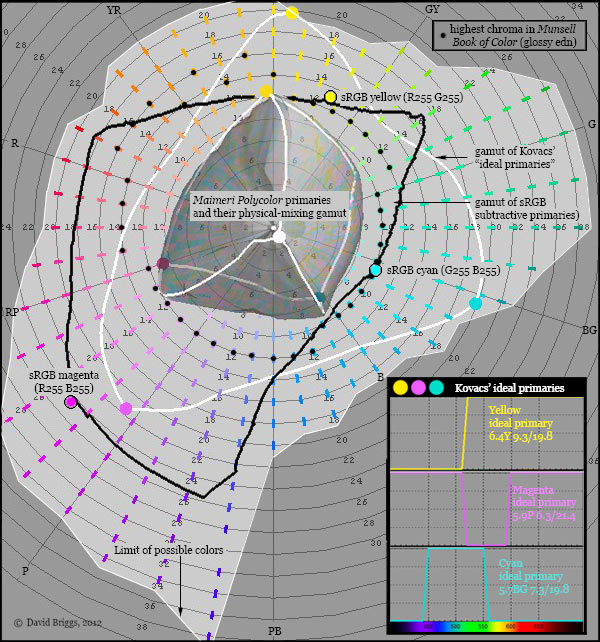my colour short course is
now offered online through
Australia's National Art
School in Sydney! There's
a choice of two sessions to
suit every time zone. LINK
Home
The Dimensions of Colour
Basics of Light and Shade
Basics of Colour Vision
Additive Mixing
Subtractive Mixing
Hue
Lightness and Chroma
Brightness and Saturation
Principles of Colour
Afterthoughts
Glossary
References
Contact
Links
NEXT COLOUR
WORKSHOPS

5.2 IDEAL SUBTRACTIVE PRIMARIES
Imagine a set of three hypothetical, perfect filters, each transparent to about a third of the spectrum, and completely opaque to the remainder, constructed such that they each let through a band of wavelengths like one of the red, green and blue optimal colour additive primaries in Fig. 4.1.1. These perfect filters would be extremely difficult to manufacture from physical colourants, but in the digital realm our full-chroma red, green and blue colours work exactly like this when they are mixed subtractively (in Multiply mode). A moment's thought will show that these ideal red, green and blue filters would be completely unsuitable as primaries for subtractive mixing. These filters by definition have no wavelengths in common, and so any pair at full strength would absorb all light, making black, and changing the strength of one of the filters would not result in intermediate hues (Fig. 5.2.1).
Figure 5.2.1. Subtractive mixing of ideal colourants corresponding to the optimal colour additive primaries. Filters that let through only one additive primary at a time would not work for subtractive mixing. Varying the strength of the red (top slider) , green (middle slider) and blue (bottom slider) colourants does not produce intermediate hues. Rectangles show the phosphors glowing in each filter and (top left) in the overlap of all three. Copyright David Briggs and Ray Kristanto, 2007.
To work as perfect primaries for subtractive mixing, the filters would instead need to completely transmit two of the additive primaries at a time, and completely absorb the third. There are just three pairings possible, R+G, R+B, G+B. As we saw in Section 4, these pairings are seen as yellow, magenta and cyan respectively. Each of the three possible combinations of these pairings has one and only one of the additive primaries in common. Yellow (R+G) and magenta (R+B), for example, having red in common, and at full intensity mix subtractively to make red (Fig. 5.2.2). Changing the intensity of one or other of the components produces a continuous range of hues between yellow and magenta (Figure 5.2.3), and the corresponding yellow to cyan and cyan to magenta intermediates complete the circuit of possible hues. No wavelength is shared by all three primaries, and so subtractive mixing of the three at full intensity produces perfect black.

Figure 5.2.2. Mixing of ideal subtractive primaries at full intensity.
Figure 5.2.3. Subtractive mixing of ideal subtractive primaries. Varying the strength of the cyan (top slider) , magenta (middle slider) and yellow (bottom slider) produces a full range of intermediate hues. Rectangles show the phosphors glowing in each filter and (top left) in the overlap of all three. Copyright David Briggs and Ray Kristanto, 2007.
In the digital realm pairs our subtractive primaries can mix to make all possible RGB colours, and so these mixing relationships can be schematically expressed as a triangle (Fig 5.2.4).

Figure 5.2.4. Mixing relationships of ideal subtractive primaries.
Note however that in Munsell colour space these colours occupy a different and less regular shape, with maximum chroma at the additive primaries (Fig. 5.2.5, black outline).

Figure 5.2.5. Comparison of mixing paths of "ideal" primaries and gamut of sRGB colours (i.e. of sRGB subtractive primaries) with chroma limits of Munsell Book of Color (black dots) and limits of theoretically possible colours (Macadm limits), plotted using Zsolt Kovac's program drop2color.
In simplistic colour theory we are often informed that "in theory" we should be able to mix all colours from paints of the three primary colours, but that in practice this is not possible because our paint primaries are "imperfect". The implicit "theory" here is what I refer to as the naive conception of the primary colours: that colours are physical properties residing in objects, and that all colours are physically "made of" red, yellow and blue. In reality it is not possible for just three colours to subtractively mix all possible colours, even theoretically. To illustrate the mixing of ideal subtractive primaries in his color2drop programme, Zsolt Kovacs devised three ideal primaries with slightly overlapping spectra, but close in general hue to the RGB subtractive primaries. These ideal primaries mix a much larger gamut than is obtained by physical mixing of actual yellow, magenta and cyan paints, but still do not mix even the entire range of common object colours, as indicated by the limits of the Munsell Book of Color, let alone the entire range of theoretically possible colours. The same is true of the gamut of our digital subtractive primaries, for example the sRGB primaries also shown in Fig 5.2.5.
Modified August 12, 2012. For original (2007) page see here.
